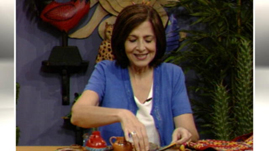Teachers' Domain - Digital Media for the Classroom and Professional Development
User: Preview



To introduce the numbers nine and 10 in Spanish, Señora Alicia shares her bolsa de sorpresas with the students. This surprise bag contains 10 authentic objects from Central America.
This video was adapted from ¡Arte y más!, originally produced by KET as a complete curriculum for primary-level Spanish based on arts and humanities content. Spanish teachers can use these resources in traditional or online instruction to reinforce language acquisition and teach about Latin American culture.
Telar de Cintura Maya Coloring Page (Document)
Weaving
Señora Alicia displays a number of traditional items in this video. A number of these items, including the bag she stores them in, are woven in the traditional styles of Latin America. Weaving is a common practice for many women in all parts of Latin America, where many symbolic patterns and animal motifs are used. The large bag, or bolsa , shown in this video is from Bolivia, which is in South America, while the smaller bags are from Central America.
In the Andes of South America, weaving is a major art. Women spin the wool of alpacas and llamas, and then weave this wool into beautiful patterns. In the time before the Spanish conquest, Incan people prized woven cloth and even used it as money to pay for goods and services.
The Mayan women of Guatemala used simple back strap looms to weave elaborate patterns for their traditional blouses, called, huipiles . They believed the goddess Ixchel invented this art form (she is also the goddess of the Moon and childbirth, as well as weaving), and so it has a very important place in their culture. Each local village in Guatemala has its own traditional pattern, which helps identify where women are from and gives them a sense of identity. Patterns are most often taken from nature and include flowers, birds, and other animals, as well as abstract symbols. (See: The Magic Box )
Teaching Tips
Activity: Let’s weave a bolsa
Vocabulary
muchas cosas, bolsa de sorpresas
For this activity, you will need:
• a black piece of construction paper with slits cut about one inch apart and starting one inch from the edge and ending one inch from the opposite edge, ten strips of brightly colored construction paper for weaving, pieces of yarn, clear tape, single hole punch
Directions
 Loading Standards
Loading Standards